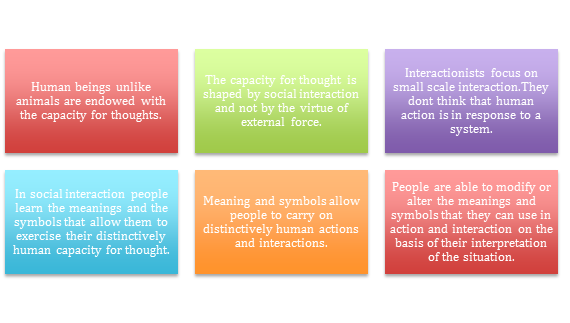Home » Symbolic Interactionism
Symbolic Interactionism
Index

Symbolic interactionism is a sociological perspective that explores how people create, interpret, and negotiate shared meanings and symbols through everyday social interactions. It emphasizes that society is not an external, objective structure but is continuously constructed and reconstructed through human interaction, language, and interpretation. People act toward things—objects, events, people—based on the meanings those things have for them, and meanings are derived from social interaction and modified through interpretation.
Origin and Evolution of the Concept
The roots of symbolic interactionism can be traced to the early 20th century, particularly within the Chicago School of Sociology, which emphasized fieldwork and the study of urban life. However, the intellectual foundation was laid by American pragmatist philosophers, especially George Herbert Mead and John Dewey.
Although Mead never formally published a book during his lifetime, his students compiled his lectures into the influential work “Mind, Self and Society” (1934), posthumously published by his student Charles W. Morris. In this book, Mead discusses how the self emerges through social interaction, particularly through taking the role of the “other.”
Major Proponent: Herbert Blumer
Herbert George Blumer (1900–1987) was a prominent American sociologist best known for coining the term “symbolic interactionism” and systematically developing it into a distinct theoretical framework within sociology. He was both a student and interpreter of George Herbert Mead, whose philosophical ideas on the self and social interaction profoundly shaped Blumer’s thinking.
Key Contributions of Herbert Blumer
1. Symbolic Interactionism (Term and Theory)
Blumer coined the term “symbolic interactionism” in a 1937 article titled Social Psychology and later fully articulated it in his major work, Symbolic Interactionism: Perspective and Method (1969). His version of symbolic interactionism focuses on the importance of meaning, language, and symbols in the process of human social interaction.
He argued that individuals do not respond automatically to stimuli from the external world; rather, they interpret and assign meaning to those stimuli through social interaction. Blumer emphasized that humans are active agents, not passive reactors.
2. The Three Core Premises of Symbolic Interactionism
Blumer outlined three basic premises of symbolic interactionism:
-
Humans act toward things based on the meanings those things have for them.
For example, a national flag is not just a piece of cloth, but a symbol of identity, patriotism, and power because people have collectively assigned that meaning to it. -
The meaning of things arises from social interaction.
Meanings are not inherent in objects or actions; they emerge through interaction. For instance, the concept of “respect” differs across cultures and contexts because it is socially constructed. -
Meanings are handled and modified through an interpretive process by individuals.
People constantly interpret and reinterpret the meanings of situations based on their interactions and experiences.
These premises make it clear that for Blumer, society is not a fixed structure; it is a dynamic, ever-evolving reality that people create and recreate through interactions.
Key Contributions
George Herbert Mead
George Herbert Mead (1863–1931) is widely regarded as the foundational
figure of symbolic interactionism, though he never published a book in his
lifetime. His students compiled his lectures posthumously in Mind, Self, and
Society (1934), which became the cornerstone of interactionist theory. Mead
believed that the self is not innate but arises through social interaction,
especially through the use of symbols and language. For Mead,
communication was not merely a tool for expressing ideas but the medium
through which individuals become self-aware and understand others.
Mead’s concept of the self is famously divided into the “I” and the “Me”. The
“I” is the spontaneous, unpredictable, and creative aspect of the self that
initiates action, while the “Me” represents the internalized attitudes and
expectations of the broader society. The balance between these two
components enables an individual to function both uniquely and socially.
A central idea in Mead’s work is the “generalized other”—the internalized
perspective of the wider community that individuals use to evaluate their own
behavior. It is through the understanding of the generalized other that
individuals learn societal norms.
Mead also outlined the stages of self-development:
- In the preparatory stage, children imitate others without understanding
- In the play stage, they take on roles of specific others (like parents or teachers).
- In the game stage, they understand multiple roles and how they interact within a group.
Through these stages, individuals develop the capacity for role-taking, which Mead viewed as essential for empathy, cooperation, and moral reasoning. His theory emphasized that the self is a social product, continuously shaped through interaction, thus laying the intellectual foundation for symbolic interactionism and influencing generations of sociologists aer him.
Key Contributors: George Herbert Mead, Erving Goffman and Charles Horton Cooley
Erving Goffman
Erving Goffman (1922–1982) was a Canadian-born sociologist who significantly expanded symbolic interactionist thought through his groundbreaking work on everyday social interaction, particularly in his theory of dramaturgy. In his seminal book The Presentation of Self in Everyday Life (1959), Goffman conceptualized social life as a series of theatrical performances, where individuals are actors playing roles before an audience.
In this framework, people engage in impression management—the process of controlling how they are perceived by others. The “front stage” represents the public performance, where individuals conform to expected norms, while the “back stage” is where they can express their true selves without social judgment. For example, a teacher may maintain authority in the classroom (front stage) but relax and complain at home (back stage). This analysis revealed how identity is not fixed, but carefully craed and maintained through social cues and symbolic gestures.
Goffman also introduced concepts like face-work, frames, and stigma, each explaining how individuals navigate social order, deviance, and labeling. His book Stigma (1963) explored how individuals with socially discredited identities manage social interactions and conceal or reveal aspects of themselves.
Unlike Mead or Blumer, Goffman focused less on the development of the self and more on interaction order—the unstated rules and rituals of everyday encounters. His microsociological perspective exposed the complex, performative nature of routine behaviors, revealing how power, hierarchy, and social control operate even in casual settings.
Though not always identified directly as a symbolic interactionist, Goffman’s work fits squarely within its framework and has had a profound influence on fields such as identity studies, deviance, medical sociology, and communication theory.
Charles Horton Cooley
Charles Horton Cooley (1864–1929) was an early American sociologist and a foundational thinker in symbolic interactionism, best known for introducing the concept of the “looking-glass self”. Cooley argued that the self is not a solitary entity but is deeply social, formed through interactions with others and shaped by our perception of how others see us.
According to Cooley’s concept, the development of self involves three steps:
- We imagine how we appear to others.
- We imagine how others judge that appearance.
- We develop feelings (like pride or shame) based on that imagined judgment
This process creates the “looking-glass self”, in which we see ourselves
reflected in the responses and evaluations of others. For example, a child who
is consistently praised learns to see themselves as capable and valued, whereas
one who is ridiculed may internalize a negative self-image. Thus, self-concept
is constructed not in isolation but through social feedback.
Cooley’s work laid the foundation for understanding self and identity as
socially constructed rather than biologically predetermined. He emphasized
sympathetic introspection—understanding individuals by imagining oneself
in their position—as a research method.
His broader perspective on primary groups, such as family and close friends,
further highlighted the importance of intimate, face-to-face interactions in
shaping human behavior and social cohesion. Unlike later theorists who
focused more on strategic interaction or role-playing, Cooley stressed the
emotional and moral dimensions of human relationships.
Though he preceded Mead and Blumer, Cooley’s work is integral to symbolic
interactionism. His insights continue to influence studies in social psychology,
child development, communication, and identity, especially in how people
come to understand themselves through others.
References
- Blumer, H. (1969). Symbolic interactionism: Perspective and method. Englewood Cliffs, NJ: Prentice-Hall.
- Mead, G. H. (1934). Mind, self, and society: From the standpoint of a social behaviorist. Chicago, IL: University of Chicago Press.
- Goffman, E. (1959). The presentation of self in everyday life. Garden City, NY: Doubleday.
- Cooley, C. H. (1902). Human nature and the social order. New York, NY: Charles Scribner’s Sons.
Symbolic interactionism is an interaction between human beings via symbols such as words, definitions, roles, gestures, rituals etc. Symbolic interactionism focuses on the nature of interaction the dynamic patterns of social action and social relationship. Whatever form of interaction takes place it emerges from a particular situation. Symbolic interactionism as a concept was formulated by Herbert Blumer but given by Mead. It is a socio-psychological perspective as it focuses on small-scale interpersonal relations. In this individuals are viewed as active constructors of their own conduct to interpret, evaluate, define and map out their own actions rather than being passive persons influenced by outside forces. This approach stresses on the process by which the individuals make decisions and form opinions.
In Mead�s view human thought experience and conduct are essentially social. Symbols impose particular meanings on objects and these meanings are constructed and reconstructed in the process of social interaction. Symbolic interaction is necessary since man has no instincts to direct his behavior. He is not genetically programmed to react automatically to particular stimuli. In order to survive he has to find medium of interaction with others and symbols filled the lacuna. Via symbols meaning is imposed on the world of nature and human interaction with that world is there by made possible. Mead defines a symbol as the stimulus whose response is given in advance. He argues that through the process of role taking the individual develops a concept of self. By placing himself in the position of others he is able to look back upon himself. Mead claims that the idea of a self can only develop if the individual can get outside himself in such a way so as to become an object to himself. Symbolic interactionism is an anti theoretical sociological theory that refuses in principle to transcend the peculiar characteristics of social processes. It goes towards conceptual generalization and abstraction and allowing concepts to function at best a sensitizing function. They always try to interpret a particular situation rather than a set of general situations.
Symbolic interaction was influenced by the view of Charles Horton Cooley that the sense of self is not self-generating but it is developed through interaction with significant others. In our social interaction other people act like a mirror or looking glass in which we see ourselves. What other people think of us is like a mirror image of ourselves in society. A person compares his self-image to how others perceive him.
Joel M Charon in his Symbolic Interactionism: An Introduction, An Interpretation, An Integration, 2004 highlights five characteristics of Symbolic Interaction which include the assumptions that human beings should be considered as social and thinking beings, human perceive their environments subjectively and not objectively, cause of human action lies in present and they are not passive to their environment. The crucial assumption that human beings possess the ability to think differentiates symbolic interactionism from its behaviorist roots. The ability to think enables people to act reflectively rather than just behave unreflectively. The ability to think is embedded in the mind and mind is different from physiological brain. Mind is a result of socialization process and it is not a thing but is a process.
The basic principles of symbolic interaction can be as following

|
|
Symbolic interactionism is also criticized of having a narrow micro focus. It ignores certain common facts like power, structure and their constraining influence on human actions and interactions. They examine human interaction in a vacuum. They focus only on small face-to-face interaction and ignore the larger social settings. According to Skidmore interactionists fail to explain why people consistently choose to act in a given ways in certain ways instead of all possible ways. They ignore the social constraints. Symbolic interactionism embodies American values of liberty, freedom and individuality and is biased by it and deliberately ignores the harsher reality of life. Marxists argue that meanings that are generated are not a result of interaction but external force due to presence of class relationships.

 |
© 2025 sociologyguide |
 |













